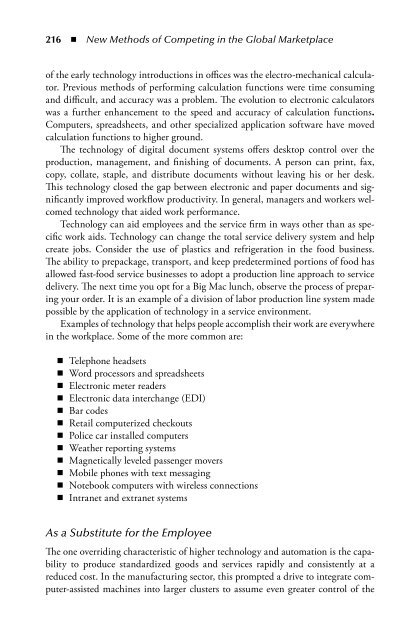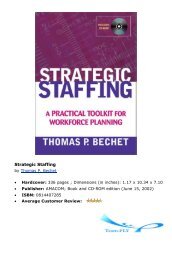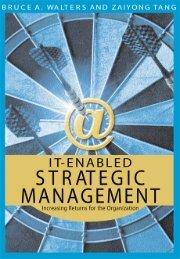- Page 2 and 3:
New Methods of Competing in the Glo
- Page 4 and 5:
New Methods of Competing in the Glo
- Page 6:
Dedication This book is dedicated t
- Page 9 and 10:
iii n Contents Changing Personal an
- Page 11 and 12:
x n Contents Why Are Management Pro
- Page 13 and 14:
xii n Contents Sales and Operations
- Page 15 and 16:
xi n Contents The Four Classical Ma
- Page 17 and 18:
x i n Contents Demand Variation ...
- Page 19 and 20:
x iii n Contents The Need for an In
- Page 22 and 23:
Foreword Walk into any fast food-ch
- Page 24 and 25:
Acknowledgments We have a number of
- Page 26:
Acknowledgments n xx about grammar,
- Page 29 and 30:
xx iii n Introduction Chapter 7 - T
- Page 31 and 32:
xxx n Introduction disparate discip
- Page 34 and 35:
Chapter 1 The Vanishing Manufacturi
- Page 36 and 37:
The Vanishing Manufacturing/Service
- Page 38 and 39:
The Vanishing Manufacturing/Service
- Page 40 and 41:
The Vanishing Manufacturing/Service
- Page 42 and 43:
The Vanishing Manufacturing/Service
- Page 44 and 45:
The Vanishing Manufacturing/Service
- Page 46 and 47:
The Vanishing Manufacturing/Service
- Page 48 and 49:
The Vanishing Manufacturing/Service
- Page 50 and 51:
The Vanishing Manufacturing/Service
- Page 52 and 53:
Chapter 2 Critical Success Factors
- Page 54 and 55:
Critical Success Factors and Strate
- Page 56 and 57:
Critical Success Factors and Strate
- Page 58 and 59:
n n n n n Critical Success Factors
- Page 60 and 61:
n n n n n Critical Success Factors
- Page 62 and 63:
Critical Success Factors and Strate
- Page 64 and 65:
Critical Success Factors and Strate
- Page 66 and 67:
Critical Success Factors and Strate
- Page 68 and 69:
What Is Strategic Planning? Critica
- Page 70 and 71:
n n n Critical Success Factors and
- Page 72 and 73:
n n n n n n To be most useful, CSFs
- Page 74 and 75:
Critical Success Factors and Strate
- Page 76 and 77:
n n n Critical Success Factors and
- Page 78 and 79:
Critical Success Factors and Strate
- Page 80 and 81:
Critical Success Factors and Strate
- Page 82 and 83:
Critical Success Factors and Strate
- Page 84 and 85:
Chapter 3 The ITO Model John dreame
- Page 86 and 87:
The ITO Model n this supply chain t
- Page 88 and 89:
The ITO Model n the systems objecti
- Page 90 and 91:
n n The ITO Model n independent var
- Page 92 and 93:
Table - Examples of ITO Modules Typ
- Page 94 and 95:
The ITO Model n tribution company d
- Page 96 and 97:
The ITO Model n and customization o
- Page 98 and 99:
The ITO Model n We can combine tran
- Page 100 and 101:
The ITO Model n At the end of this
- Page 102 and 103:
The ITO Model n Figure 3-7 shows th
- Page 104 and 105:
The ITO Model n possible, the techn
- Page 106 and 107:
Table - The Effect of Variation on
- Page 108 and 109:
The ITO Model n obvious and simple,
- Page 110 and 111:
n n The ITO Model n Products, mater
- Page 112 and 113:
System Design and Implementation Th
- Page 114 and 115:
The ITO Model n into an integrated
- Page 116 and 117:
Chapter 4 The Role of Management Pr
- Page 118 and 119:
n n n n n The Role of Management Pr
- Page 120 and 121:
The Role of Management Programs n W
- Page 122 and 123:
The Role of Management Programs n p
- Page 124 and 125:
Normal transformation process Condi
- Page 126 and 127:
The Role of Management Programs n T
- Page 128 and 129:
Number of Articles 600 500 400 300
- Page 130 and 131:
The Role of Management Programs n s
- Page 132 and 133:
The Role of Management Programs n o
- Page 134 and 135:
The Role of Management Programs n 0
- Page 136 and 137:
The Role of Management Programs n 0
- Page 138 and 139:
The Role of Management Programs n 0
- Page 140 and 141:
Failure to Match Program with Need
- Page 142 and 143:
n n The Role of Management Programs
- Page 144 and 145:
n n n The Role of Management Progra
- Page 146 and 147:
The Role of Management Programs n l
- Page 148:
The Role of Management Programs n 1
- Page 151 and 152:
n New Methods of Competing in the G
- Page 153 and 154:
0 n New Methods of Competing in the
- Page 155 and 156:
n New Methods of Competing in the G
- Page 157 and 158:
Low Importance of structured flow H
- Page 159 and 160:
n New Methods of Competing in the G
- Page 161 and 162:
n New Methods of Competing in the G
- Page 163 and 164:
0 n New Methods of Competing in the
- Page 165 and 166:
n New Methods of Competing in the G
- Page 167 and 168:
n n n n New Methods of Competing in
- Page 169 and 170:
n New Methods of Competing in the G
- Page 171 and 172:
n n n n n New Methods of Competing
- Page 173 and 174:
0 n New Methods of Competing in the
- Page 175 and 176:
n New Methods of Competing in the G
- Page 177 and 178:
n New Methods of Competing in the G
- Page 180 and 181:
Chapter 6 How Service Techniques Ar
- Page 182 and 183:
How Service Techniques are Being Ex
- Page 184 and 185:
How Service Techniques are Being Ex
- Page 186 and 187:
How Service Techniques are Being Ex
- Page 188 and 189:
How Service Techniques are Being Ex
- Page 190 and 191:
How Service Techniques are Being Ex
- Page 192 and 193:
How Service Techniques are Being Ex
- Page 194 and 195:
Distributive Services How Service T
- Page 196 and 197:
How Service Techniques are Being Ex
- Page 198 and 199: How Service Techniques are Being Ex
- Page 200 and 201: n n n n n Benefits How Service Tech
- Page 202 and 203: How Service Techniques are Being Ex
- Page 204 and 205: Vendor-Managed Inventory (VMI) How
- Page 206 and 207: n n How Service Techniques are Bein
- Page 208 and 209: How Service Techniques are Being Ex
- Page 210 and 211: How Service Techniques are Being Ex
- Page 212 and 213: How Service Techniques are Being Ex
- Page 214 and 215: How Service Techniques are Being Ex
- Page 216 and 217: How Service Techniques are Being Ex
- Page 218 and 219: How Service Techniques are Being Ex
- Page 220 and 221: How Service Techniques are Being Ex
- Page 222 and 223: How Service Techniques are Being Ex
- Page 224 and 225: How Service Techniques are Being Ex
- Page 226 and 227: How Service Techniques are Being Ex
- Page 228 and 229: Chapter 7 The Role of Technology in
- Page 230 and 231: The Role of Technology in Continuou
- Page 232 and 233: The Role of Technology in Continuou
- Page 234 and 235: The Role of Technology in Continuou
- Page 236 and 237: The Role of Technology in Continuou
- Page 238 and 239: The Role of Technology in Continuou
- Page 240 and 241: The Role of Technology in Continuou
- Page 242 and 243: The Role of Technology in Continuou
- Page 244 and 245: The Role of Technology in Continuou
- Page 246 and 247: The Role of Technology in Continuou
- Page 250 and 251: The Role of Technology in Continuou
- Page 252 and 253: The Role of Technology in Continuou
- Page 254 and 255: n n n n The Role of Technology in C
- Page 256 and 257: The Role of Technology in Continuou
- Page 258 and 259: The Role of Technology in Continuou
- Page 260 and 261: The Role of Technology in Continuou
- Page 262 and 263: The Role of Technology in Continuou
- Page 264 and 265: The Role of Technology in Continuou
- Page 266 and 267: The Role of Technology in Continuou
- Page 268 and 269: Summary The Role of Technology in C
- Page 270 and 271: The Role of Technology in Continuou
- Page 272 and 273: The Role of Technology in Continuou
- Page 274 and 275: Chapter 8 The Role of Infrastructur
- Page 276 and 277: The Role of Infrastructure in Conti
- Page 278 and 279: The Role of Infrastructure in Conti
- Page 280 and 281: The Role of Infrastructure in Conti
- Page 282 and 283: Functional The Role of Infrastructu
- Page 284 and 285: The Role of Infrastructure in Conti
- Page 286 and 287: The Role of Infrastructure in Conti
- Page 288 and 289: The Role of Infrastructure in Conti
- Page 290 and 291: The Role of Infrastructure in Conti
- Page 292 and 293: The Role of Infrastructure in Conti
- Page 294 and 295: The Role of Infrastructure in Conti
- Page 296 and 297: The Role of Infrastructure in Conti
- Page 298 and 299:
The Role of Infrastructure in Conti
- Page 300 and 301:
The Role of Infrastructure in Conti
- Page 302 and 303:
The Role of Infrastructure in Conti
- Page 304 and 305:
Chapter 9 Understanding Organizatio
- Page 306 and 307:
Understanding Organizational Cultur
- Page 308 and 309:
What Is Organizational Culture? Und
- Page 310 and 311:
Understanding Organizational Cultur
- Page 312 and 313:
Understanding Organizational Cultur
- Page 314 and 315:
Understanding Organizational Cultur
- Page 316 and 317:
Values Understanding Organizational
- Page 318 and 319:
Understanding Organizational Cultur
- Page 320 and 321:
Understanding Organizational Cultur
- Page 322 and 323:
Understanding Organizational Cultur
- Page 324 and 325:
n n n Understanding Organizational
- Page 326 and 327:
Understanding Organizational Cultur
- Page 328 and 329:
Understanding Organizational Cultur
- Page 330 and 331:
Understanding Organizational Cultur
- Page 332 and 333:
Understanding Organizational Cultur
- Page 334 and 335:
Understanding Organizational Cultur
- Page 336 and 337:
Understanding Organizational Cultur
- Page 338 and 339:
Understanding Organizational Cultur
- Page 340 and 341:
Chapter 10 Integrated Supply Chains
- Page 342 and 343:
Table 0- Status of Lean Supply Chai
- Page 344 and 345:
Supply Chain Management (Expanded)
- Page 346 and 347:
Integrated Supply Chains n the futu
- Page 348 and 349:
n n n n Integrated Supply Chains n
- Page 350 and 351:
Integrated Supply Chains n Collabor
- Page 352 and 353:
n n Integrated Supply Chains n Deli
- Page 354 and 355:
Transition from Batch Flow to Lean
- Page 356 and 357:
n n n n Integrated Supply Chains n
- Page 358 and 359:
Integrated Supply Chains n in desig
- Page 360 and 361:
Integrated Supply Chains n Now is t
- Page 362 and 363:
n n n n n Integrated Supply Chains
- Page 364 and 365:
Integrated Supply Chains n chains t
- Page 366 and 367:
Integrated Supply Chains n customer
- Page 368 and 369:
Integrated Supply Chains n They con
- Page 370 and 371:
Integrated Supply Chains n of the c
- Page 372 and 373:
Integrated Supply Chains n Dealing
- Page 374 and 375:
Conclusions Integrated Supply Chain
- Page 376 and 377:
Integrated Supply Chains n 22. Cigo
- Page 378 and 379:
Chapter 11 The Role of Services to
- Page 380 and 381:
The Role of Services to Complement
- Page 382 and 383:
The Role of Services to Complement
- Page 384 and 385:
The Role of Services to Complement
- Page 386 and 387:
The Role of Services to Complement
- Page 388 and 389:
The Role of Services to Complement
- Page 390 and 391:
n n n n n The Role of Services to C
- Page 392 and 393:
n n n n n n The Role of Services to
- Page 394 and 395:
n The Role of Services to Complemen
- Page 396 and 397:
The Role of Services to Complement
- Page 398 and 399:
The Role of Services to Complement
- Page 400 and 401:
The Role of Services to Complement
- Page 402 and 403:
The Role of Services to Complement
- Page 404 and 405:
The Role of Services to Complement
- Page 406 and 407:
The Role of Services to Complement
- Page 408 and 409:
The Role of Services to Complement
- Page 410:
The Role of Services to Complement
- Page 413 and 414:
0 n New Methods of Competing in the
- Page 415 and 416:
n New Methods of Competing in the G
- Page 417 and 418:
n New Methods of Competing in the G
- Page 419 and 420:
n New Methods of Competing in the G
- Page 421 and 422:
n New Methods of Competing in the G
- Page 423 and 424:
0 n New Methods of Competing in the
- Page 425 and 426:
n New Methods of Competing in the G
- Page 427 and 428:
n New Methods of Competing in the G
- Page 429 and 430:
n New Methods of Competing in the G
- Page 431 and 432:
n New Methods of Competing in the G
- Page 433 and 434:
00 n New Methods of Competing in th
- Page 435 and 436:
0 n New Methods of Competing in the
- Page 437 and 438:
0 n New Methods of Competing in the
- Page 439 and 440:
0 n New Methods of Competing in the
- Page 441 and 442:
0 n New Methods of Competing in the
- Page 443 and 444:
0 n New Methods of Competing in the
- Page 446 and 447:
Index A Administrative management,
- Page 448 and 449:
components of, 282-291 identity, 27
- Page 450 and 451:
Input-Transformation-Output Model.
- Page 452 and 453:
technology, 206-209 Manufacturing t
- Page 454 and 455:
manufacturing, services, difference
- Page 456:
infrastructure, 201-202 integrated




